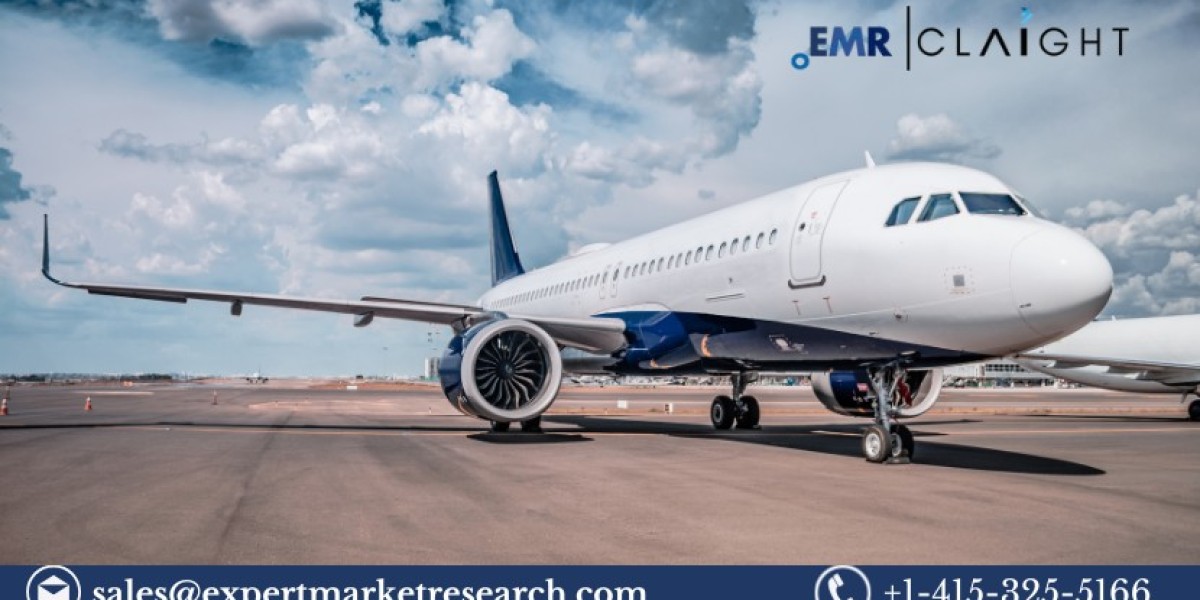The commercial aircraft market has been a key sector in the global aerospace industry, and it continues to show impressive growth despite the challenges brought on by global economic fluctuations and unforeseen events. In 2024, the global commercial aircraft market reached a value of approximately USD 178.51 billion. With a robust annual growth forecast, this market is expected to grow at a compound annual growth rate (CAGR) of 4.3% between 2025 and 2034, reaching an estimated value of around USD 249.99 billion by 2034.
In this article, we will provide a detailed overview of the commercial aircraft market by exploring its outlook, key trends, dynamics, opportunities, challenges, and competition in the sector.
Commercial Aircraft Market Outlook
The commercial aircraft market is poised for a significant expansion during the next decade, with airlines and aviation operators continually increasing their fleet sizes to meet the demands of rising global air travel. The market's recovery post-pandemic and a steady rise in air passenger traffic contribute heavily to its promising growth trajectory. As of 2024, the market stands at approximately USD 178.51 billion, with an expected annual growth rate of 4.3% over the forecast period, reaching around USD 249.99 billion by 2034.
North America currently holds the leading position in the global commercial aircraft market. The region benefits from a highly developed aviation infrastructure, robust fleet renewal programs, and a strong presence of key aircraft manufacturers like Boeing and Lockheed Martin. The Asia Pacific region, however, is witnessing the fastest growth, driven by expanding economies, increasing disposable incomes, and a growing middle class that is fueling the demand for air travel.
The major factors driving this growth include the rising demand for air travel, technological advancements in aircraft manufacturing, and the emergence of low-cost carriers in many parts of the world. Additionally, the expansion of airports and the growth of the tourism sector are also expected to significantly influence the market's outlook.
Commercial Aircraft Market Trends
Several notable trends are shaping the commercial aircraft market:
Technological Advancements in Aircraft Design
Advancements in aircraft design and engineering are driving the evolution of the commercial aircraft market. Innovations such as lighter and more fuel-efficient materials, quieter engines, and advanced aerodynamics are helping airlines reduce operational costs. The development of electric and hybrid aircraft also promises to revolutionize the market by offering environmentally friendly alternatives to traditional aviation fuels.
Fleet Modernization and Expansion
Airlines around the world are focused on fleet modernization to enhance fuel efficiency, reduce operating costs, and improve passenger comfort. Newer aircraft models, including the Boeing 787 and Airbus A350, are more fuel-efficient and provide better overall performance compared to older models, prompting many airlines to invest in these advanced aircraft.
Rise of Low-Cost Carriers (LCCs)
Low-cost carriers are gaining market share globally, especially in emerging economies in Asia Pacific and Latin America. LCCs are expanding rapidly by providing affordable air travel to passengers who previously may have opted for other forms of transportation. This trend is contributing to increased demand for commercial aircraft as LCCs expand their fleets.
Sustainability and Environmental Concerns
With increasing emphasis on sustainability, the commercial aviation industry is working towards reducing its carbon footprint. Airlines are exploring alternative fuels, and there is an increasing focus on the development of sustainable aircraft technologies. Electric and hybrid-powered aircraft are expected to gain traction in the coming years, transforming the industry and making air travel more environmentally friendly.
Get a Free Sample Report with Table of Contents:
https://www.expertmarketresearch.com/reports/commercial-aircraft-market/requestsample
Commercial Aircraft Market Dynamics & Trends
The commercial aircraft market is influenced by several dynamics and trends that shape its growth and development. These include:
Demand for Air Travel
Global passenger air traffic is a key driver of the commercial aircraft market. Increased demand for air travel, especially in emerging markets in Asia Pacific and Africa, is fueling the need for more aircraft. Growing economies, better connectivity, and affordable air travel options are propelling this demand.
Regulatory and Safety Standards
Strict regulatory and safety standards play a significant role in shaping the commercial aircraft market. Regulatory bodies such as the Federal Aviation Administration (FAA) and the European Union Aviation Safety Agency (EASA) enforce stringent safety guidelines that manufacturers must follow, which ensures that only the highest quality aircraft are delivered to airlines.
Fuel Prices and Operational Costs
The price of fuel is one of the most significant operational expenses for airlines, directly impacting their profitability. Fluctuations in fuel prices can influence aircraft purchase decisions, as more fuel-efficient aircraft are in demand when fuel prices rise. Similarly, fuel-efficient designs and green technologies can help airlines reduce costs, making them an attractive investment.
Geopolitical Factors
Geopolitical factors, including trade policies, tariffs, and political instability, can have an impact on the commercial aircraft market. For instance, trade disputes between major economies can disrupt the supply chain for aircraft manufacturers, leading to delays or cost increases. However, a stable geopolitical environment often results in a healthy growth trajectory for the aviation industry.
Technological Disruptions
Advancements in artificial intelligence (AI), data analytics, and the Internet of Things (IoT) are bringing new efficiencies to the commercial aircraft market. AI-powered predictive maintenance is enabling airlines to minimize downtime, while IoT is improving real-time monitoring of aircraft systems. These innovations are reducing maintenance costs, enhancing passenger safety, and improving the overall efficiency of operations.
Commercial Aircraft Market Opportunities
The commercial aircraft market presents numerous opportunities for growth, development, and innovation. Some of the most notable opportunities include:
Growing Air Travel Demand in Emerging Markets
One of the most significant opportunities for the commercial aircraft market lies in emerging economies. Countries in Asia Pacific, Africa, and Latin America are experiencing rapid economic growth, leading to an increase in disposable incomes and a greater demand for air travel. Airlines in these regions are investing in new fleets to accommodate this surge in demand.
Advancements in Aircraft Materials and Manufacturing
Manufacturers of commercial aircraft are continuously developing new materials and manufacturing techniques that reduce aircraft weight, improve fuel efficiency, and lower overall production costs. This offers an opportunity for suppliers of advanced composites, lightweight materials, and new technologies to enter the market.
Emerging Aircraft Technologies
The development of electric and hybrid aircraft presents a tremendous opportunity in the commercial aircraft market. With airlines looking to reduce their carbon footprint, these technologies offer a more sustainable and cost-efficient alternative to traditional aviation fuels. Manufacturers are already working on prototypes, and these aircraft are expected to enter commercial service in the next decade.
Partnerships and Alliances
Strategic partnerships between aircraft manufacturers, airlines, and other stakeholders are presenting new growth opportunities. By collaborating on new aircraft designs, advanced technologies, and cost-sharing initiatives, these entities can tap into shared expertise and resources, accelerating innovation and market growth.
Commercial Aircraft Market Challenges
While the commercial aircraft market offers substantial growth prospects, it also faces several challenges that must be addressed:
High Initial Investment Costs
Aircraft are expensive, and the initial capital investment required by airlines to purchase new aircraft can be a significant hurdle. Airlines often rely on financing and leasing options to offset these costs, but high investment requirements can limit market growth, especially for smaller carriers or operators in developing regions.
Economic Downturns and Global Crises
The commercial aircraft market is vulnerable to global economic downturns and crises such as the COVID-19 pandemic, which can severely impact air travel demand. During such periods, airlines may delay fleet expansion, reduce the frequency of flights, or retire older aircraft, affecting the overall demand for new aircraft.
Supply Chain Disruptions
The commercial aircraft manufacturing process is highly complex and relies on a global supply chain. Disruptions in supply chains due to political instability, natural disasters, or logistical challenges can lead to production delays and cost increases, hampering the ability of manufacturers to meet market demand.
Environmental Concerns and Regulatory Challenges
As governments and organizations push for greater environmental responsibility, the commercial aircraft industry must navigate a complex landscape of evolving regulations concerning emissions, fuel efficiency, and sustainability. Meeting these new requirements while maintaining profitability will be a significant challenge for manufacturers and airlines.
Competitor Analysis in the Commercial Aircraft Market
The commercial aircraft market is highly competitive, with major players vying for market share. Some of the key competitors in the industry include:
ATR: A joint partnership between Airbus and Leonardo, ATR specializes in regional turboprop aircraft, offering solutions for short to medium-haul regional travel, popular for their fuel efficiency and low operating costs.
Embraer S.A.: A Brazilian aerospace company recognized for its regional jets, Embraer competes with larger manufacturers like Boeing and Airbus, with strong offerings in the 70-130 seat range, catering to both commercial and military sectors.
Textron Inc.: An American conglomerate that manufactures a wide range of aircraft, including small and medium-sized commercial aircraft through its subsidiary Cessna, which serves the regional and private jet markets.
General Dynamics Corporation: Known for its defense and aerospace operations, General Dynamics produces commercial aircraft through its subsidiary Gulfstream Aerospace, primarily focusing on high-performance business jets.
Others: Other key players in the market include smaller manufacturers, regional suppliers, and emerging players that contribute to aircraft production, innovation, and market diversification.
Explore our trending Blogs & Reports:
Biggest Construction Companies:
https://www.expertmarketresearch.com/articles/top-construction-companies
Media Contact:
Company Name: Claight Corporation
Contact Person: James Jon, Business Consultant
Email: sales@expertmarketresearch.com
Toll Free Number: US +1-415-325-5166 | UK +44-702-402-5790
Address: 30 North Gould Street, Sheridan, WY 82801, USA
Website: www.expertmarketresearch.com







